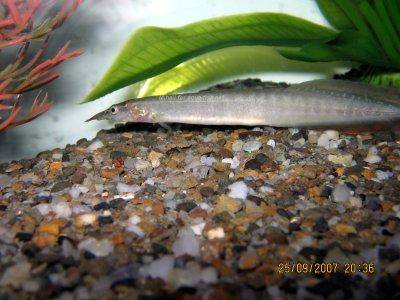Peacock eel - Macrognathus siamensis
Scientific name: Macrognathus siamensis
Common name: Peacock eel
Family: Mastacembelidae
Usual size in fish tanks: 24 - 31 cm (9.45 - 12.2 inch)
014
Recommended pH range: 6.3 - 7.3
Recommended water hardness: 7 - 15°N (125 - 267.86ppm)
0°C 32°F30°C 86°F
Recommended temperature range: 22 - 27 °C (71.6 - 80.6°F)
The way how these fish reproduce: Spawning
Where the species comes from: East Asia
Temperament to its own species: peaceful
Temperament toward other fish species: aggressive to smaller
Usual place in the tank: Bottom levels
Origin
The Peacock Eel is found all over South East Asia. They prefer waterways with little water flow and can even be found in paddy fields in the wild.
Lifespan
The expected life span for Macrognathus siamensis is 5 years.
Short description
Unusually for spiny eels, the peacock likes to be in a group of its own species. As they only reach a length of 14” they are more suited to home aquariums than some of the other species. As these fish like to burrow, always use a sand substrate and never keep them with small tank mates as they are predators. They may stay burrowed most of the time in the daylight hours but should become more active once settled in the aquarium. They are ideal for first time keepers of spiny eels but this family of fish should only be cared for by keepers with some experience. They get their common name of peacock eel from their distinctive markings but they can also be known as the Spot finned spiny eel or even the Siamese spiny eel.
The aquarium should be planted and hiding places provided by using rocks or wood. They can be housed in a community set up with larger species of fish as they are not aggressive and they will even co-exist alongside their own kind as long as the aquarium provides ample room for them.
Never use bright lighting with the Peacock Eel, this can make them unsettled, they prefer dim lighting and well oxygenated water.
Cautionary notes
Eels are very susceptible to diseases if they are present in tank mates within the aquarium. They are very prone to White spot disease so the water quality must be kept high with regular water changes. Any fish being treated with medications should be moved to a quarantine tank as medications can also affect the health of Eels.
Food and feeding
Getting eels can be difficult to start with, supply them with live foods initially, blood worms, brine shrimp and daphnia are ideal. As the eel settles in more, they should start to accept the same foods in the frozen form. Eventually they will accept food readily but as always patience is required as they do need to settle properly in the aquarium.
Sexing
Females tend to be larger with a fuller body shape.
Breeding
The male will chase the female around the tank and she will then scatter the eggs around the substrate for the male to fertilise. The eggs should hatch in 3-4 days and the fry, when free swimming, can be fed on rotifers or newly hatched brine shrimp. The mortality rate for the fry may be high as they are prone to fungal infections.
Pictures
Provided by Mihail of Romania and some pictures were bought by aqua-fish.net from jjphoto.dk.









 Tire
Tire